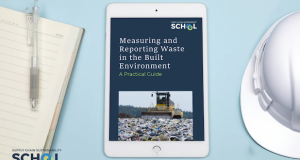MEASUREMENT
Measuring waste management performance means establishing the metrics against which progress will be judged. Cost savings will be seen on the bottom line, while quantifying environmental improvements can include the number of trees saved, equivalent cars taken off the road, or carbon dioxide equivalents if measuring carbon emissions.
Periodic waste assessments will help monitor the effectiveness of waste reduction and recycling programmes and a reputable waste management provider will be able to supply accurate collection data.
GAINING SUPPORT AT ALL LEVELS
Waste management plans work best if they have support at all levels of the business.
A successful programme will hinge on getting the right people on board and engaged, setting tangible target and budgets, and ensuring there is time and resource to manage the creation and implementation of the strategy.
This is where working with a reputable waste management provider can really pay off, as their expertise, knowledge, and experience can help with reducing waste, driving cost-savings, inform environmentally preferable purchasing, and ultimately save time and effort.
COMMUNICATION
Good communication is crucial to success.
 It’s well recognised that employee engagement is one of the hardest things to get right and one of the easiest to get wrong. After all, why should someone bother to walk to the kitchen to put their apple core in a food waste caddy when they could simply throw it in the general waste bin? And does it really matter if a few plastic cups end up in the cardboard container?
It’s well recognised that employee engagement is one of the hardest things to get right and one of the easiest to get wrong. After all, why should someone bother to walk to the kitchen to put their apple core in a food waste caddy when they could simply throw it in the general waste bin? And does it really matter if a few plastic cups end up in the cardboard container?
There are many ways to engage with and encourage employees to deal with waste responsibly, including:
- Waste Awareness Days in partnership with a waste provider
- Creation of a ‘green team’ of waste champions
- Installation of new bins with easy-to-understand signage
- Production of posters and clear signage
- Incentive programmes
- Dissemination of results, ie increases in recycling
- Entry into awards
COMPLIANCE
As the survey revealed, FMs consider legislative and regulatory compliance as the most important aspect of their portfolio.
Nearly 94 per cent of FMs surveyed said they believe the facilities management department or function plays an active role in the management of compliance for their organisation, with over 88 per cent believing their FM role actively mitigates both reputational and financial risk.
So what is the easiest way to manage compliance and avoid either financial or reputational risk? The simplest solution is to streamline waste collection services under one roof.
 It is the responsibility of the waste management provider to be up-to-date with the latest legislation, allowing FMs to focus on making sure the processes put in place are delivering the right results.
It is the responsibility of the waste management provider to be up-to-date with the latest legislation, allowing FMs to focus on making sure the processes put in place are delivering the right results.
Audit trails, regular environmental reporting statistics, and updates on compliance matters all provide essential feedback for several reasons, including:
- Verifying that intended goals are being met
- Tracking operational efficiencies and cost savings made
- Identifying where further improvements need to be made
- Monitoring employee engagement and satisfaction
- Reporting on successes (or failures) helps to inform the next steps
- Provides valuable evidence and ammunition for future budget and strategic planning
SEGREGATION
Segregating waste is an important part in ensuring compliance. For example, Environment Agency legislation means that in a commercial environment, everyday items such as cleaning chemicals, batteries, aerosols, paints, adhesives and even printer toner cartridges fall into the category of hazardous waste.
Simply disposing of such items in your general waste risks a substantial fine, which could also impact on an organisation’s reputation.
A reputable waste management company will provide clearly labelled and colour-coded bags, bins and containers for each identified waste stream, as well as identifying the best locations for the maximum use.
Correct segregation can also have a dramatic impact when it comes to the bottom line – by driving both efficiencies and cost savings.




